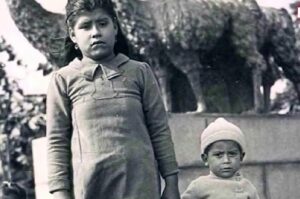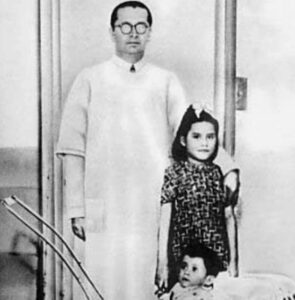
Born on September 23, 1933, in one of the poorest villages in Peru, Lina Medina was one of nine children of Tiburelo Medina and Victoria Losea. Her pregnancy at such an early age obviously came as a disturbing shock to her loved ones — and the public. But to pediatric endocrinologists, the idea that a 5-year-old child could get pregnant wasn’t entirely unthinkable.
It’s believed that Medina had a rare genetic condition called precocious puberty, which causes a child’s body to change into that of an adult too soon (before age eight for girls and before age nine for boys).
Boys with this condition will often experience a deepening voice, enlarged genitals, and facial hair. Girls with this condition will typically have their first period and develop breasts early on. It affects about one in every 10,000 children. Roughly 10 times more girls than boys develop this way.
Oftentimes, the cause of precocious puberty can’t be identified. However, recent studies have found that young girls who were sexually abused may go through puberty faster than their peers. So there are suspicions that precocious puberty might be accelerated by sexual contact at an early age.
In the case of Lina Medina, Dr. Edmundo Escomel reported to a medical journal that she had her first period when she was only eight months old. However, other publications claimed that she was three years old when she began menstruating. Either way, it was a shockingly early start.
Further examination of 5-year-old Medina showed that she had already developed breasts, wider-than-normal hips, and advanced (that is, post-pubescent) bone growth.
But of course, even though her body was developing early, she was still very clearly a young child.
Lina Medina never told authorities who the father of the child was. Sadly, it’s possible that even she didn’t know.
Precocious puberty partially explains how Lina Medina got pregnant. But of course, it doesn’t explain everything.
After all, somebody else had to get her pregnant. And sadly, given the 100,000-to-1 odds against it, that person probably wasn’t a little boy with the same condition that she had.
Medina never told her doctors or the authorities who the father was or the circumstances of the assault that led to her pregnancy. But due to her young age, she might not have even known herself.
Dr. Escomel said that she “couldn’t give precise responses” when questioned about the father.
Tiburelo, Medina’s father who worked as a local silversmith, was briefly arrested for the suspected rape of his child. However, he was released and the charges against him were dropped when no evidence or witness statements could be found to hold him responsible. For his part, Tiburelo Medina strenuously denied ever raping his daughter.
In the years following the birth, some news agencies speculated that Medina may have been attacked during unspecified festivities that took place near her village. However, this was never proven.
Once Lina Medina’s pregnancy became generally known, it garnered attention from all over the world.
Newspapers in Peru unsuccessfully offered the Medina family thousands of dollars for the rights to interview and to film Lina. Meanwhile, newspapers in the United States had a field day reporting on the story — and they also attempted to interview the youngest mother in the world.
Offers were even made to pay the family to come to the United States. But Medina and her family declined to speak publicly.
It was perhaps inevitable, given the astounding nature of Medina’s condition and her aversion to scrutiny, that some observers would accuse her family of hoaxing the whole story.
In the over 80 years that have passed, this seems unlikely to be the case. Neither Medina nor her family have tried to capitalize on the story, and medical records from the time provide ample documentation of her condition during her pregnancy.
Only two photographs were known to be taken of Medina while she was pregnant. And only one of those — a low-resolution profile picture — was ever published outside of the medical literature.
Her case file also contains numerous accounts by doctors who treated her, as well as clearly defined X-rays of her abdomen that show the bones of a developing fetus inside her body. Blood work also confirmed her pregnancy. And all papers published in the literature passed peer review without a hitch.
That said, every request for an interview has been refused by Medina. And she would go on to avoid publicity for the rest of her life, refusing to sit for interviews with international wire services and local newspapers alike.
Medina’s aversion to the spotlight apparently continues to this day.
What Happened To Lina Medina, The Youngest Person To Ever Give Birth?

Much of Lina Medina’s later life remains a mystery. If she’s still alive today, she’d be in her late 80s.
Lina Medina seems to have gotten good medical care, especially for the time and place in which she lived, and she gave birth to a healthy baby boy.
Delivery was by Cesarean section because, despite Medina’s prematurely widened hips, she probably would’ve had a difficult time passing a full-sized child through the birth canal.
Lina Medina’s child was named Gerardo, after the doctor who first examined Medina, and the infant went home to the family’s village of Ticrapo after he was released from the hospital.
Two years after the birth, a specialist in child education at Columbia University named Paul Kosak got permission to visit the Medina family. Kosak found that the youngest person to give birth was “above normal intelligence” and that her baby was “perfectly normal.”
“She thinks of the child as a baby brother and so does the rest of the family,” Kosak reported.
An obstetrician named Jose Sandoval, who wrote a book about the Medina case, said that Medina often preferred to play with her dolls rather than her child. As for Gerardo Medina himself, he grew up thinking that Medina was his older sister. He found out the truth when he was about 10.
While Gerardo Medina was healthy for most of his life, he sadly ended up dying relatively young at age 40 in 1979. The cause of death was bone disease.
As for Lina Medina, it is unclear if she’s still alive today or not. After her shocking pregnancy, she went on to live a quiet life in Peru.
In her young adulthood, she found work as a secretary for the doctor who attended the birth, which paid her way through school. At roughly the same time, Lina managed to put Gerardo through school as well.
She later married a man named Raúl Jurado in the early 1970s and gave birth to her second son when she was in her 30s. As of 2002, Medina and Jurado were still married and living in a poor neighborhood in Lima.
Given her lifelong attitude toward publicity and the prying eyes of curious outsiders towards history’s youngest person to give birth, it may be for the best that Lina Medina’s life remains private. If she’s still alive, she would be in her late 80s today.